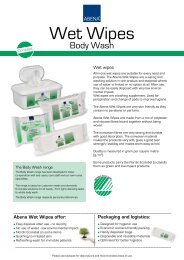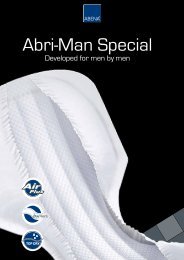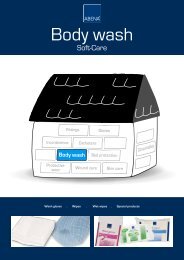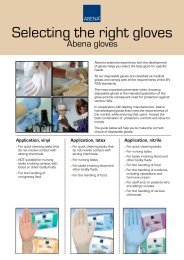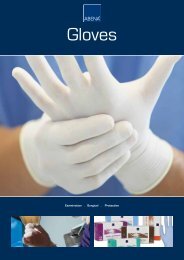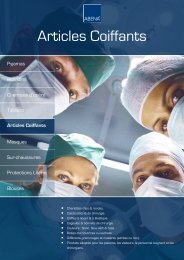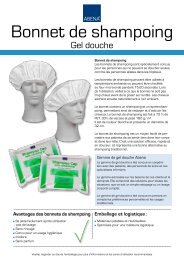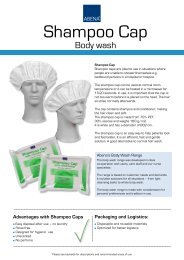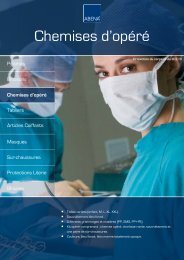Correct techniques
Correct techniques
Correct techniques
- No tags were found...
You also want an ePaper? Increase the reach of your titles
YUMPU automatically turns print PDFs into web optimized ePapers that Google loves.
<strong>Correct</strong> <strong>techniques</strong>for assessing incontinencefor those suffering from urine incontinenceDefinition:“Urine incontinence is every kind of involuntary urinaryleakage”. (International Continence society 2005)• There are many and varied possible causes ofurinary incontinence• The patient should be offered a thoroughassessment according to the ‘minimal careprinciple’ i.e. simple, non invasive assessmentmethods should be used• This should be carried out by a nurse whospecialises in this particular disciplineWho needs assessment?Anyone who requests incontinence aids. The initialrequest may come from:• The patient• Homecare• The doctor1. Visit (duration approx. 1 hour)• Data collection• Urine analysis• Analysis of hygiene and the skin in the genital region• Analysis of the need for filling out a ‘ContinenceFluid Chart’• Analysis and evaluation of the data collected2. Visit (duration approx. ½ hour)• Analysis of ‘Continence Fluid Chart’• Analysis of data collection• Evaluation of data collection• Assessment of the need for aids• Eventually a further assessment with the GeneralPractitioner will be required3. Visit (duration approx. ½ hour)• Final evaluation of the data collected• Implementation of treatment as outlined by theGeneral Practitioner• Assessment of the requirement for aidsConsultation withthe General PractitionerWhen visiting the GP, the client must bring the datacollection analysis and the fluid chartVisit the assessment program for generalpractice at: www.dsam.dkFollow-up visitsAssessment of the effectiveness of the initialevaluation and the aids used
Symptoms and treatmentSYMPTOMS:Stress incontinence• Incontinent when exercising• Minor leakages• Normal urination pattern• No urination urge connected withleakages• Complete emptying of the bladderwhen visiting the toilet• It is rare that urine would be left inthe bladder after a visit to the toiletUrge incontinence• Involuntary urination with a strongneed for urination• Often a significant leakage• Frequent minor leakages• Difficult to reach the toilet in time• It is rare that urine would be left inthe bladder after a visit to the toiletOverflow incontinence• Seeping emptying of the bladderoften connected with physicalactivities• Frequent minor urination• Frequent urinary tract infection• Poor emptying of the bladder meansthere is a significant amount of urineleft in the bladder after emptyingIt is important to note that a person may suffer from both stress and urge incontinence. Treatment is then focused onthe most debilitating type.TREATMENT FOR:Stress incontinence• Urination training• Pelvic floor training• Oestrogen treatment/postmenopausal• Advice on producing sterile urine• Vaginal aids• Surgery• Incontinence padsUrge incontinence• Urination training• Pelvic floor training• Oestrogen treatment/postmenopausal• Scheduled urination/bladdertraining based on the maximumcapacity of the bladder i.e. urinationbefore the urge for urination exists• Pharmaceutical drugs for bladderrelaxation• Advice on producing sterile urine• Incontinence padsOverflow• Urination training• Double or triple voiding i.e. urinatingin intervals of a few minutes• Scheduled urination approximatelyevery 3-4 hours, even if there is nourge to urinate• RIK/SIK clean or sterile intermittentcatheterization• If the prostate is enlarged,medical treatment or an operation isrecommended• Incontinence padsThe following depicts normal bladder function in elderly people:• Bladder capacity:.......................................... 200 – 400 ml• Daily diurese:.................................................1000 – 1500 ml• Urination frequency (day time):.....................6 – 8 urinations• Urination frequency (night time):..................1 – 2 urinationsOn average, we need to drink approx. 1.5 litres of fluid per day including: coffee, tea, beer, yoghurt etc.www.abena.comSK80/DK/06.2006 / 936623



